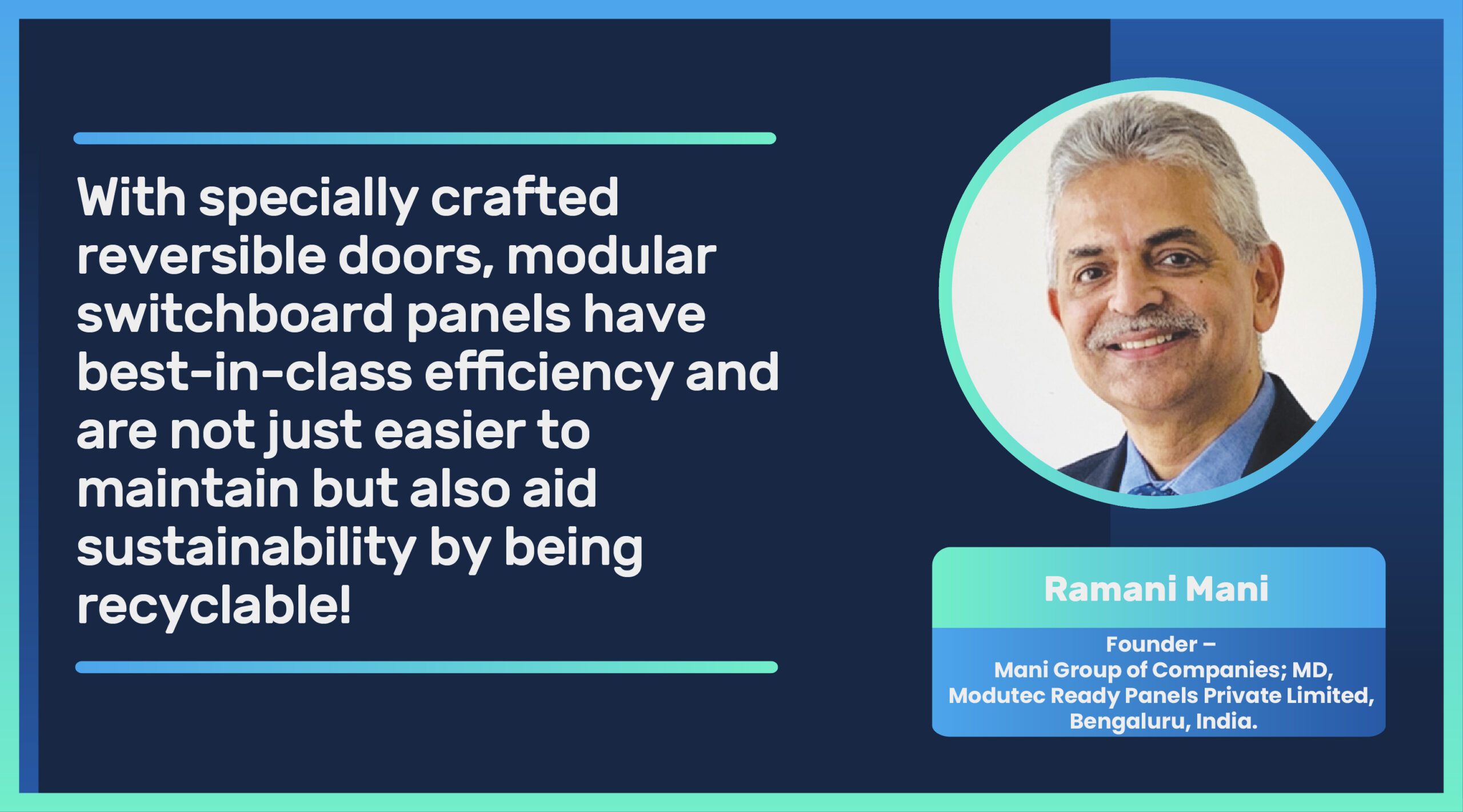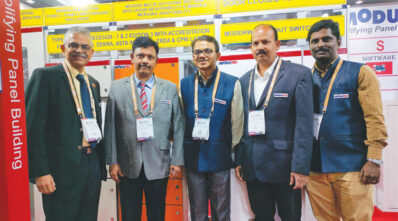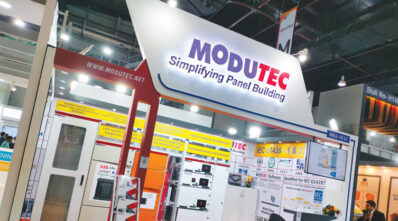Modular switchboard panels are vital for safer power operations in fixed & draw-out versions
By EPR Magazine Editorial March 10, 2023 6:37 pm IST
By EPR Magazine Editorial March 10, 2023 6:37 pm IST

Modutec Ready Panels exhibited four panels at ELECRAMA-
Form1 enclosures are generally used by OEMs & for VFDs, PLC & automation panels.
Power control centres, which have ACB verticals and MCCB verticals for incoming & outgoing. “These power distribution panels have been type-tested to IEC 61439 1&2 with six switchgear makes, giving clients a wide range of options. MODSIM software that supports estimation, engineering & execution is also here for a demo.” Explains Mr Ramani Mani.
Draw out MCC & PCC enclosure systems with door-closed technology, which was introduced at ELECRAMA 2023.
Pan Assemblies in a fish bone structure that aid MCCB incomer with MCB or MCCB outgoings in TP & 4P combinations.

What are the essential benefits of designing installations with draw-out switchboards?
First, let us understand why people prefer “draw-out panels”, especially in process and process-critical businesses. Here even a few seconds without, say, a starter feeder can stop the process or impact the product quality. Therefore, if there’s an issue with this particular starter feeder, we can take it out and have another alternative from ready stock fitted in without needing a power shutdown. So technology has a vital role to play here, which our R&D team has painstakingly developed. And a key benefit is also the fact that the door-closed technology makes it safer for men operating and materials in the vicinity of the Switchboard.
And what are the features of your MCC and PCC Enclosures of the fixed type?
When we embark on serving electrical installations, we have the Customer & then his end client to be considered. Each has different ideas, needs and urgencies at different times. We also have a third dimension of the Specifier’s perception of safety, reliability & convenience to be understood. This adaptability is the appeal of a modular system. For example, in the beginning, if we had two nos of 10 hp starters in two modules, one below the other, but there was a last-minute modification because the customer now needed one 20 hp starter instead; there is nothing you can do about it in a welded panel, other than adding another vertical at the end of the Panel and praying that there would be space to accommodate it. However, in our modular construction, one can remove the crossbar separating the modules and change the two doors to one bigger one, which can even be done at the site! This is the level of adaptability provided by a modular system.
Furthermore, all our doors are reversible from right to left and left to right, a feature seldom seen in conventional welded panels.
What kind of investments have you made in these products to increase efficiency and expand this line? What are your plans for this?
We have MODSIM software that assists us in more effectively marketing the product. Software programmes must be fast and transparent in product pricing. Here, a username and password will be assigned to the consumer. Because the programme is hosted in the cloud, any Panel Partner with an internet connection may access it, work on it, and receive an estimate.
Another software module allows us to obtain the development drawings in CAD for each mechanical product using their catalogue numbers, which can then be fed straight into a CNC machine for our license partners.
We continue to invest in this software to give customers switchboard internal layouts and busbar development drawings. We will also add electrical switchgear to ensure the estimation covers both mechanical and electrical. While moving in this direction, we are confident that the software will strengthen the basis of our operations, enabling us to simplify panel building across the globe.

What inspired you to innovate modular panels and draw-out panels in India?
International brands manufacturing modular switchboard enclosure systems have greatly influenced me. While travelling overseas, I was fascinated by this modular panel technology. I’ve even been to India’s largest panel-building businesses and learned much from what works there. After that, I assembled a team and evolved a modular technology, which I feel is the simplest to use. At the close of 2000, we successfully used modular technology for our switchboard business. After that, I thought, “Why not share the idea with the rest of the world?” That is how Modutec got its start.
What is the life expectancy of these panels and the maintenance required for these panels?
If we examine a welded panel, the joint tends to retain air, where corrosion begins. A modular design, which forgoes welding, puts us ten steps ahead regarding anti-corrosion qualities and, thus, high life expectancy.
The second factor is the metal selection. Alu-zinc is a metal alloy made of zinc and aluminium and is typically used because it has 22 % greater corrosion-resistant qualities than CRCA steel sheet with powder coating. I believe using alu-zinc in low-voltage switchboards has been our pioneering effort in India. The life expectancy of a switchboard enclosure also depends on how effectively they are engineered. Since all panels produced at Modutec use CNC equipment, the usually anticipated 20-year life expectancy could double.
For more details visit: https://modutec.net/
We use cookies to personalize your experience. By continuing to visit this website you agree to our Terms & Conditions, Privacy Policy and Cookie Policy.